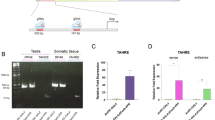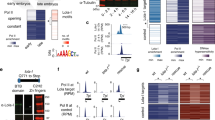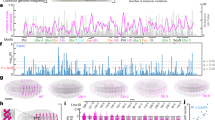Abstract
The Drosophilia melanogaster alcohol dehydrogenase (Adh) gene is transcribed from two closely linked promoters1,2, which are regulated by two upstream enhancers. The proximal promoter is active primarily in first to early third-instar larvae, whereas the distal promoter is active in late third-instar larvae and adults (Fig. 1). The Adh larval enhancer and the proximal promoter are separated by the Adh adult enhancer and the distal promoter. Because the proximal promoter is turned off just as the distal promoter is turned on, we considered the possibility that the distal promoter or adult enhancer has a role in the downregulation of the proximal promoter. We report here that transcription from the distal promoter is required to shut off the proximal promoter. In the absence of the distal promoter, the proximal promoter is active throughout larval development and in adults. The proximal promoter is also aberrantly active in adults when placed upstream of the distal promoter. These results suggest that the developmental switch from proximal to distal promoter is regulated by the stage-specific activation of the distal promoter, and the subsequent repression of the proximal promoter by transcriptional interference3–8.
This is a preview of subscription content, access via your institution
Access options
Subscribe to this journal
Receive 51 print issues and online access
$199.00 per year
only $3.90 per issue
Buy this article
- Purchase on Springer Link
- Instant access to full article PDF
Prices may be subject to local taxes which are calculated during checkout
Similar content being viewed by others
References
Benyajati, C., Spoerel, N., Haymerle, H. & Ashburner, M. Cell 33, 125–133 (1983).
Savakis, C., Ashburner, M. & Willis, J. H. Devl Biol. 114, 194–207 (1986).
Hausler, B. & Somerville, R. L. J. molec. Biol. 127, 353–356 (1979).
Adhya, S. & Gottesman, M. Cell 29, 939–944 (1982).
Cullen, B. R., Lomedico, P. & Ju, G. Nature 307, 241–245 (1984).
Proudfoot, N. J. Nature 322, 562–565 (1986).
Bateman, E. & Paule, M. R. Cell 54, 985–992 (1988).
Gay, N. J., Tybulewicz, V. L. & Walker, J. E. Biochem. J. 234, 111–117 (1986).
Heberlein, U. & Tjian, R. Nature 331, 410–415 (1988).
Bruns, G. A. & Ingram, V. M. Phil. Trans. R. Soc. B266, 225–305 (1973).
Brown, J. L. & Ingram, V. M. J. biol. Chem. 249, 3960–3972 (1974).
Choi, O. B. & Engle, J. D. Cell 55, 17–26 (1988).
Posakony, J. W., Fischer, J. A. & Maniatis, T. Cold Spring Harb. Symp. quant. Biol. 50, 515–520 (1985).
Spradling, A. C. & Rubin, G. M. Cell 34, 47–57 (1983).
Maniatis, T., Fritsch, E. F. & Sambrook, J. Molecular Cloning (Cold Spring Harbor Laboratories, New York, 1982).
Rubin, G. M. & Spradling, A. C. Nucleic Acids Res. 11, 6341–6351 (1983).
Karess, R. E. & Rubin, G. M. Cell 38, 135–146 (1984).
Rubin, G. M. & Sprading, A. C. Science 218, 348–353 (1982).
Spradling, A. C. & Rubin, G. M. Science 218, 341–347 (1982).
Goldberg, D. A., Posakony, J. W. & Maniatis, T. Cell 34, 58–73 (1983).
Fischer, J. A. & Maniatis, T. EMBO J. 5, 1275–1289 (1986).
Zinn, K., DiMaio, D. & Maniatis, T. Cell 34, 865–879 (1983).
Benyajati, C., Place, A., Wang, N., Pentz, E. & Sofer, W. Nucleic Acids Res. 10, 7261–7272 (1982).
Melton, D. et al. Nucleic Acids Res. 12, 7035–7056 (1984).
Author information
Authors and Affiliations
Rights and permissions
About this article
Cite this article
Corbin, V., Maniatis, T. Role of transcriptional interference in the Drosophila melanogaster Adh promoter switch. Nature 337, 279–282 (1989). https://doi.org/10.1038/337279a0
Received:
Accepted:
Issue Date:
DOI: https://doi.org/10.1038/337279a0
This article is cited by
-
BORDER proteins protect expression of neighboring genes by promoting 3′ Pol II pausing in plants
Nature Communications (2019)
-
One-two punch mechanism of gene repression: a fresh perspective on gene regulation
Current Genetics (2018)
-
Transcription through enhancers suppresses their activity in Drosophila
Epigenetics & Chromatin (2013)
-
Regulation of T cell receptor-α gene recombination by transcription
Nature Immunology (2006)
-
A reason for reading nonsense
Nature (2004)
Comments
By submitting a comment you agree to abide by our Terms and Community Guidelines. If you find something abusive or that does not comply with our terms or guidelines please flag it as inappropriate.



